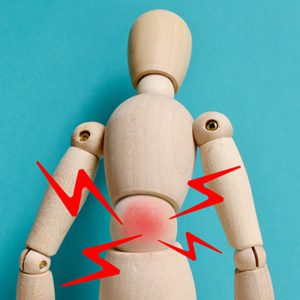Endo-App Lernmodul
Schmerzbewältigung
Worum geht es?
Zunächst soll dir dieses Modul grundlegende Informationen zu Schmerzen vermitteln. Je besser du die Mechanismen und Einflussfaktoren bei Schmerzen verstehst, desto besser weißt du, was dir helfen kann.
Modul-Autor:in

Teresa Götz – klinische Psychologin M.Sc.
Wissenschaftliche Grundlagen des Moduls
Teresa Götz ist Psychologin und Expertin für Schmerzbewältigung bei Endometriose und progressive Muskelentspannung.
Zur Erstellung des Moduls wurden unter anderem folgende Quellen genutzt:
Abokhrais IM, Denison FC, Whitaker LHR, Saunders PTK, Doust A, Williams LJ, Horne AW (2020). A two-arm parallel double-blind randomised controlled pilot trial of the efficacy of Omega-3 polyunsaturated fatty acids for the treatment of women with endometriosis-associated pain (PurFECT1). PLoS One. 2020 Jan 17;15(1):e0227695. doi: 10.1371/journal.pone.0227695. Erratum in: PLoS One. 2020 Feb 27;15(2):e0230055. PMID: 31951599; PMCID: PMC6968860.
Adib Rad H, Basirat Z, Bakouei F, Moghadamnia AA, Khafri S, Farhadi Kotenaei Z, Nikpour M, Kazemi S. Effect of Ginger and Novafen on menstrual pain: A cross-over trial. Taiwan J Obstet Gynecol. 2018 Dec;57(6):806-809. doi: 10.1016/j.tjog.2018.10.006. PMID: 30545531.
Andresen T, Lunden D, Drewes AM, Arendt-Nielsen L. Pain sensitivity and experimentally induced sensitisation in red haired females. Scand J Pain. 2011 Jan 1;2(1):3-6. doi: 10.1016/j.sjpain.2010.08.005. PMID: 29914002.
Buhle JT, Stevens BL, Friedman JJ, Wager TD. Distraction and placebo: two separate routes to pain control. Psychological science. 2012;23(3):246–253. https://doi.org/10.1177/0956797611427919
Bushnell MC, Case LK, Ceko M, Cotton VA, Gracely JL, Low LA, Pitcher MH, Villemure C. Effect of environment on the long-term consequences of chronic pain. Pain. 2015;156 Suppl 1(0 1):42–49. https://doi.org/10.1097/01.j.pain.0000460347.77341.bd
Dos Bispo AP, Ploger C, Loureiro AF, Sato H, Kolpeman A, Girão MJ, Schor E. Assessment of pelvic floor muscles in women with deep endometriosis. Archives of gynecology and obstetrics. 2016;294(3):519–523. https://doi.org/10.1007/s00404-016-4025-x
Eisenberger NI. The pain of social disconnection: examining the shared neural underpinnings of physical and social pain. Nature reviews. Neuroscience. 2012;13(6):421–434. https://doi.org/10.1038/nrn3231
Eshaghian R, Mazaheri M, Ghanadian M, Rouholamin S, Feizi A, Babaeian M. The effect of frankincense (Boswellia serrata, oleoresin) and ginger (Zingiber officinale, rhizoma) on heavy menstrual bleeding: A randomized, placebo-controlled, clinical trial. Complement Ther Med. 2019 Feb;42:42-47. doi: 10.1016/j.ctim.2018.09.022. Epub 2018 Sep 27. PMID: 30670277.
Forbes H, Fichera E, Rogers A, Sutton M. The Effects of Exercise and Relaxation on Health and Wellbeing. Health economics. 2017:26(12), e67–e80. https://doi.org/10.1002/hec.3477
Funk JL, Frye JB, Oyarzo JN, Chen J, Zhang H, Timmermann BN. Anti-Inflammatory Effects of the Essential Oils of Ginger (Zingiber officinale Roscoe) in Experimental Rheumatoid Arthritis. PharmaNutrition. 2016 Jul;4(3):123-131. doi: 10.1016/j.phanu.2016.02.004. Epub 2016 Jun 4. PMID: 27872812; PMCID: PMC5115784
Gehirn&Geist, 8/2016
Gehirn&Geist 10/2017
Gehirn&Geist, 3/2018
Glier B. Chronische Schmerzen bewältigen: Verhaltenstherapeutische Schmerzbehandlung. Stuttgart: Klett-Cotta; 2004.
Guy L, McKinstry C, Bruce C. Effectiveness of Pacing as a Learned Strategy for People With Chronic Pain: A Systematic Review. The American journal of occupational therapy : official publication of the American Occupational Therapy Association. 2019;73(3):7303205060p1–7303205060p10. https://doi.org/10.5014/ajot.2019.028555
Haack M, Simpson N, Sethna N, Kaur S, Mullington J. Sleep deficiency and chronic pain: potential underlying mechanisms and clinical implications. Neuropsychopharmacology : official publication of the American College of Neuropsychopharmacology. 2020;45(1):205–216. https://doi.org/10.1038/s41386-019-0439-z
Harms, H. Psychologische Schmerzbewältigung: Ein pragmatisches Konzept für die Gruppenarbeit. München: Ernst Reinhardt Verlag; 2009.
Jibb LA, Khan JS, Seth P, Lalloo C, Mulrooney L, Nicholson K, Stinson JN. Electronic Data Capture Versus Conventional Data Collection Methods in Clinical Pain Studies: Systematic Review and Meta-Analysis. J Med Internet Res. 2020;22(6), e16480. doi:10.2196/16480
Kross E, Berman MG, Mischel W, Smith EE, Wager TD. Social rejection shares somatosensory representations with physical pain. Proceedings of the National Academy of Sciences of the United States of America. 2011;108(15):6270–6275. https://doi.org/10.1073/pnas.1102693108
Lefebvre JC, Jensen MP. The relationships between worry, happiness and pain catastrophizing in the experience of acute pain. European journal of pain (London, England). 2019;23(7):1358–1367. https://doi.org/10.1002/ejp.1405
Lima LV, Abner T, Sluka KA. Does exercise increase or decrease pain? Central mechanisms underlying these two phenomena. The Journal of physiology. 2017;595(13):4141–4150. https://doi.org/10.1113/JP273355
Liu K, Chen Y, Wu D, Lin R, Wang Z, Pan L. Effects of progressive muscle relaxation on anxiety and sleep quality in patients with COVID-19. Complementary therapies in clinical practice. 2020;39, 101132. https://doi.org/10.1016/j.ctcp.2020.101132
McCarberg B, Peppin J. Pain Pathways and Nervous System Plasticity: Learning and Memory in Pain. Pain medicine (Malden, Mass.). 2019;20(12):2421–2437. https://doi.org/10.1093/pm/pnz017
Mogil JS. Sex differences in pain and pain inhibition: Multiple explanations of a controversial phenomenon. Nature Reviews Neuroscience. 2012;13(12):859-866.
Nijs J, Kosek E, Van Oosterwijck J, Meeus M. Dysfunctional endogenous analgesia during exercise in patients with chronic pain: to exercise or not to exercise?. Pain physician. 2012;15(3 Suppl):ES205–ES213.
Ozgoli G, Goli M, Moattar F. Comparison of effects of ginger, mefenamic acid, and ibuprofen on pain in women with primary dysmenorrhea. J Altern Complement Med. 2009 Feb;15(2):129-32. doi: 10.1089/acm.2008.0311. PMID: 19216660.
Pinel JPJ, Pauli P. Biopsychologie. Pearson Studium; 2007.
Reddan MC, Young H, Falkner J, López-Solà M, Wager TD. Touch and social support influence interpersonal synchrony and pain. Social cognitive and affective neuroscience. 2020;15(10):1064–1075. https://doi.org/10.1093/scan/nsaa048
Spektrum der Wissenschaft (10/2015)
Shoba G, Joy D, Joseph T, Majeed M, Rajendran R, Srinivas PS. Influence of piperine on the pharmacokinetics of curcumin in animals and human volunteers. Planta Med. 1998 May;64(4):353-6. doi: 10.1055/s-2006-957450. PMID: 9619120.
Simmen RCM, Kelley AS. Seeing red: diet and endometriosis risk. Ann Transl Med. 2018 Dec;6(Suppl 2):S119. doi: 10.21037/atm.2018.12.14. PMID: 30740440; PMCID: PMC6330594.
Turner JA, Anderson ML, Balderson BH, Cook AJ, Sherman KJ, Cherkin DC. Mindfulness-based stress reduction and cognitive behavioral therapy for chronic low back pain: similar effects on mindfulness, catastrophizing, self-efficacy, and acceptance in a randomized controlled trial. Pain. 2016;157(11):2434–2444. https://doi.org/10.1097/j.pain.0000000000000635
Ziadni MS, Sturgeon JA, Darnall BD. The relationship between negative metacognitive thoughts, pain catastrophizing and adjustment to chronic pain. European journal of pain (London, England). 2018;22(4):756–762. https://doi.org/10.1002/ejp.1160
Modulinhalte:
- Tag 1: Einleitung
- Tag 2: Wie Schmerzen entstehen
- Tag 3: Chronische vs. akute Schmerzen
- Tag 4: Schmerzgedächtnis
- Tag 5: Teufelskreis der Schmerzen
- Tag 6: Strategien gegen Schmerzen
- Tag 7: Ablenkung
- Tag 8: Sport und Bewegung
- Tag 9: Ruhe und Aktivität
- Tag 10: Schmerzstillende Lebensmittel
- Tag 11: Entspannung
- Tag 12: Achtsamkeit
- Tag 13: Ziele und Unterstützung suchen



